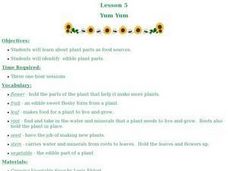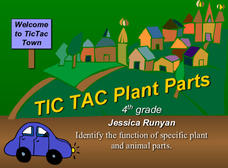Curated OER
Growing Seeds
In this science worksheet, students read 5 different scenarios with varied growing conditions for plants. Students make a prediction for each: Will it grow a little, grow a lot, or not grow at all?
Curated OER
Salt is Good On Sunflower Seeds, But What About Cypress?
Young scholars record their observations about growing a cypress plant and putting salt in the plant. In this cypress plant lesson plan, students observe and record what is happening as the cypress plant grows. This gives directions for...
Curated OER
Classifying Monocot And Dicot Plants
Sixth graders identify the parts of a flower, and tell the difference between monocots and dicots. They group plant by leaf types and characteristics placing the information in table form on the computer.
Curated OER
Flowering Plants
Pupils conduct online research to investigate gardening and landscaping tips. They determine how they can help beautify their homes and neighborhoods.
Curated OER
Energy Flow - How Much Biomass do Plants Produce?
Young scholars explore the concept of biomass. In this plant lesson, students conduct a scientific investigation that requires them to observe plant growth and biomass.
Curated OER
Rice Plants
Second graders investigate what plant is closely related to to rice. In this rice farming lesson, 2nd graders dicover the parts of rice and that rice is closely related to grass. Students create a rice picture and write sentences...
Curated OER
Habitats: must live with them....cannot live without them.
Students conduct an internet study regarding habitat, ecosystem, biome and the region they live in. They observe the habitat by visiting a State Park and observing the organisms in their habitat. In addition, they create their own...
Curated OER
Creating a Three sisters Garden
Students understand that a three sisters garden is comprised of corn, beans and squash. For this three sisters garden lesson, students understand that Native Americans planted three sisters gardens and grow a three sisters garden....
Curated OER
Tops and Bottoms
First graders classify vegetables by which parts are edible. In this plant biology lesson, 1st graders are read Tops and Bottoms by Janet Stevens, participate in a discussion of which plant parts are edible in the story, then sort...
Curated OER
Yum Yum: Making Vegetable Soup
Students investigate agriculture by reading a book. For this plant life lesson, students read the book Growing Vegetable Soup by Louis Ehlert, and examine the ingredients used in the book's soup. Students create an...
Curated OER
Chalkboard Challenge: Science Vocabulary
Students play a Jeopary-style game in this engaging PowerPoint. The scientific categories are the solar system, planet, weather, cells, and rocks. These types of interactive games are an excellent way to reinforce the important...
Curated OER
The Living Corn Necklace
Fifth graders generate two types of corn seeds, Dent corn and Indian corn to compare the similarities and differences of each of the seedlings. The preferred seedlings are determined through observations made by Students.
Curated OER
Learning the Parts of a Plant
First graders discover the anatomy of a plant by labeling a picture. In this botany instructional activity, 1st graders examine and dissect several real plants in class and define their different parts. Students utilize the...
Curated OER
Tic Tac Plant Parts
This plant biology PowerPoint introduces plant parts and their functions. This PowerPoint allows students to identify each plant part on a diagram, along with its' function. The slides contain a clear explanation of how each plant part...
Curated OER
From Genes to Jeans
This unit of lessons is designed for 7th through 9th graders. They are introduced to the world of agriculture and the genetic research and various technologies that are associated with agriculture. Pupils work together to come up with a...
Georgia Department of Education
Living Things/ Nonliving Things
How can you tell if something is living or nonliving? Introduce a set of criteria which can be used to determine which things are alive and which are not. The class discusses the basic needs of all living organisms, checks out an...
Captain Planet Foundation
P is for Poppies
Explore the way local farming and rationing helped the war effort in World War I with a lesson plan on gardening. After learning about trench warfare, reading "In Flanders' Field" by John McCrae, and studying poppies, kids discuss...
Curated OER
Plant Parts And What They Do (5.2)
In this identifying plant parts and what they do activity, students answer multiple choice, true and false, and fill in the blanks with the best vocabulary words. Students write fifteen answers.
Curated OER
Growing Up (And Around, and Down...) Exploring Plant Growth
Students build plant growing structures. In this plant growth lesson, students plant growth structures such as a garden tepee or a crawl through tunnel. They grow plants that are appropriate for the structure.
Curated OER
Name That Leaf
Take a walk through nature with a science experiment about leaves. Third graders use a branching diagram to group attributes of certain kinds of leaves, such as oak, pine, and chestnut. For extra practice, they can collect leaves and...
Curated OER
Pollination Power
Second graders study and examine the structure of a flower. In this pollination instructional activity, 2nd graders observe pollinators in the garden and dissect a flower. Students then plant strawberry plants in the garden and...
Curated OER
Bean Project (Activity in Response to the Book Jack and the Beanstalk)
In this literature and science worksheet, students respond to the book Jack and the Beanstalk by planting their own beanstalk. Students gather the 5 necessary tools and follow the 5 directions for planting a bean seed in a pot.
Curated OER
From Seed to Plant: Spelling
For this plant vocabulary worksheet, students choose the word that is spelled correctly out of the 4 words in each list regarding plant vocabulary. Students circle 15 words.
Curated OER
Indoor Gardening
Students determine how a plant grows best. In this botany lesson, students observe variables that affect plant growth. Students explore how to grow and maintain a plant. Students make observations of their plant as it grows.























